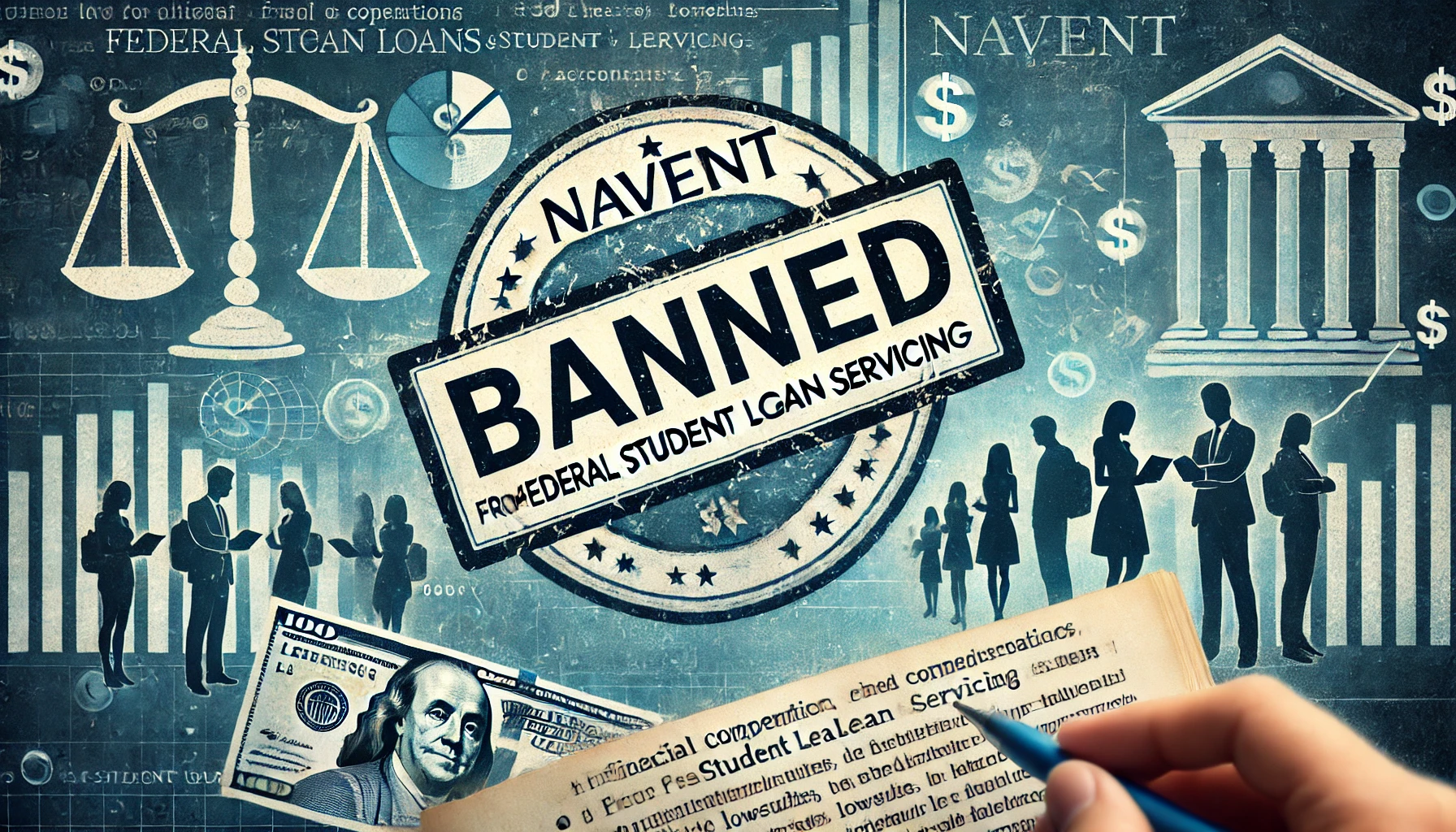The Ripple Effect of Navient’s Ban: What It Means for Student Loan Servicers and Borrowers
Navient, once a key player in federal student loan servicing, has faced significant legal repercussions that have reshaped the student loan landscape in the United States. From lawsuits and settlements to being banned from servicing federal loans, Navient’s actions have left many borrowers wondering about the next steps in managing their student debt. In this blog, we’ll dive deep into how Navient’s downfall impacts borrowers and the student loan servicing industry at large.
Navient Lawsuit and Settlement: The Beginning of the End
Navient, formerly known as Sallie Mae, was once the largest federal student loan servicer in the country. However, years of mismanagement and allegations of abusive practices led to multiple lawsuits. One of the most significant was the Navient lawsuit filed by the Consumer Financial Protection Bureau (CFPB) in 2017. The suit accused Navient of steering borrowers into forbearance rather than more beneficial income-driven repayment (IDR) plans, which could have led to faster debt forgiveness for many borrowers(Consumer Financial Protection Bureau)(Investopedia).
The Navient settlement in 2024 resulted in the company agreeing to pay $100 million to borrowers and an additional $20 million in penalties. The CFPB and Department of Education (DoE) pushed for this settlement to compensate borrowers who suffered financial harm due to Navient’s practices. More importantly, Navient was banned from servicing federal loans in the future, signaling a turning point in the student loan servicing industry.
Why Navient Was Banned from Federal Student Loan Servicing
One of the biggest outcomes of the CFPB lawsuit was the ban on Navient from ever servicing federal student loans again. But why did this happen? Navient was found guilty of steering struggling borrowers into forbearance, which led to mounting interest and delayed loan forgiveness under income-driven repayment plans. These practices disproportionately affected borrowers who would have otherwise qualified for loan forgiveness, keeping them in debt longer than necessary(Investopedia).
This ban is a significant development in the student loan world, as Navient banned signals a need for greater accountability in the loan servicing industry. It also highlights broader systemic issues, with other servicers now under pressure to meet higher standards of care and transparency when dealing with borrowers.
How the Navient Ban Impacts Student Loan Servicers
With Navient out of the picture, other student loan servicers like Aidvantage have stepped in to manage federal loans. Aidvantage, in particular, has taken over much of Navient’s former portfolio. While the transition appears smooth on the surface, it brings a host of concerns for borrowers. Many wonder if the same issues of mismanagement and miscommunication will persist under these new servicers.
The Navient Aidvantage transfer affected millions of borrowers. While Aidvantage aims to provide better service and transparency, only time will tell whether it can avoid the pitfalls that led to Navient’s downfall.
Navigating Compensation: How Borrowers Can Claim Their Share
The Navient compensation fund, part of the $100 million settlement, is designed to reimburse borrowers who were negatively impacted by Navient’s mishandling of their loans. If you believe you were wronged by Navient, it’s essential to understand the Navient compensation claim process.
To qualify, borrowers must demonstrate that they were affected by Navient’s practices, such as being steered into forbearance or suffering from improper payment allocation. Filing a claim requires submitting documentation, such as payment records, which show the mismanagement of loans.
For more detailed guidance on how to claim compensation, borrowers should consult credible resources like the Consumer Financial Protection Bureau (CFPB) website or other official announcements related to the Navient settlement. This can be a complex process, but understanding your rights as a borrower and being proactive in pursuing compensation is key.
The Role of Income-Driven Repayment Plans and Loan Forgiveness
One of the most significant aspects of the Navient scandal is how the company mishandled income-driven repayment plans. These plans are designed to offer relief to borrowers by tying monthly payments to their income, which helps them avoid defaulting on their loans. More importantly, these plans provide a clear path to student loan forgiveness after a set number of qualifying payments.
However, Navient’s mismanagement meant that many borrowers lost out on the benefits of IDR plans. In some cases, Navient student loan forgiveness was delayed or even lost entirely due to the company’s failure to properly track payments or notify borrowers of their eligibility for recertification.
For borrowers now seeking forgiveness under IDR plans, it’s crucial to work closely with your new servicer, whether that’s Aidvantage or another company, to ensure that your payments are being counted correctly and that you stay on track for loan forgiveness.
What the Future Holds for Student Loan Servicing
The Navient saga raises questions about the future of student loan servicers and the overall health of the student loan system. With Navient no longer able to service federal loans, other companies are stepping in to fill the gap. However, borrowers must remain vigilant and advocate for their rights to avoid falling victim to similar practices.
Borrowers should stay informed about changes in the loan servicing industry, including the role of the federal government in holding servicers accountable. Resources like Regent Studies provide valuable educational content to help you better understand your loan options and navigate the complex landscape of student debt.
Steps You Can Take to Protect Yourself as a Borrower
The Navient banned decision sends a clear message that abusive practices will not be tolerated. As a borrower, there are several steps you can take to protect yourself and ensure you are receiving the best possible service:
- Stay Informed: Regularly check for updates from the Department of Education and your loan servicer. Don’t hesitate to reach out for clarification if you’re unsure about your repayment plan or loan status.
- Monitor Your Payments: Keep detailed records of your payments and track your progress towards loan forgiveness, especially if you’re on an income-driven repayment plan.
- Know Your Rights: Understand your options for Navient student loan forgiveness and other debt relief programs. If you feel your servicer is not acting in your best interest, file a complaint with the CFPB or explore legal recourse.
- File for Compensation: If you believe you were wronged by Navient, follow the Navient compensation claim process to recoup any financial losses you may have incurred due to their practices.
Final Thoughts: Navient’s Legacy and Moving Forward
The downfall of Navient is a wake-up call for the student loan servicing industry. The Navient lawsuit, settlement, and federal ban have set new precedents for accountability, and the effects will be felt for years to come. As other student loan servicers like Aidvantage take over, borrowers must stay proactive and informed about their rights, especially when it comes to income-driven repayment plans and compensation claims.
With the student loan landscape constantly evolving, it’s more important than ever to stay updated on changes that might affect your debt and repayment strategy. By understanding the implications of Navient’s ban and staying vigilant in monitoring your loans, you can protect yourself and work toward a debt-free future.
For further information and expert resources on managing your student loans, visit Regent Studies.



